The pygmy date palm is one of the most popular small landscape palms in Florida. It is single-stemmed, but is often grown in clumps of 2–4 closely spaced individuals which, when older, give the impression of a multi-stemmed palm (Figure 1). It grows to a height of about 12 ft with a spread of 6–8 ft. The feather-shaped (pinnate) leaves have slender petioles and basal leaflets that are modified into sharp 2–3-inch-long spines. The slender, often crooked trunk varies in diameter from 3–6 inches and is covered with distinctive peg-like leaf bases (Figure 2). Older specimens will have a large mass of aerial root initials at the base of the trunk. Cream-colored male and female flowers are found on separate trees (dioecious) in the spring that are followed by small elongated reddish-brown fruits that turn black upon ripening. Pygmy date palm has been assessed for invasive potential by UF/IFAS and is not considered a problem species at this time, and therefore may be recommended in Florida.
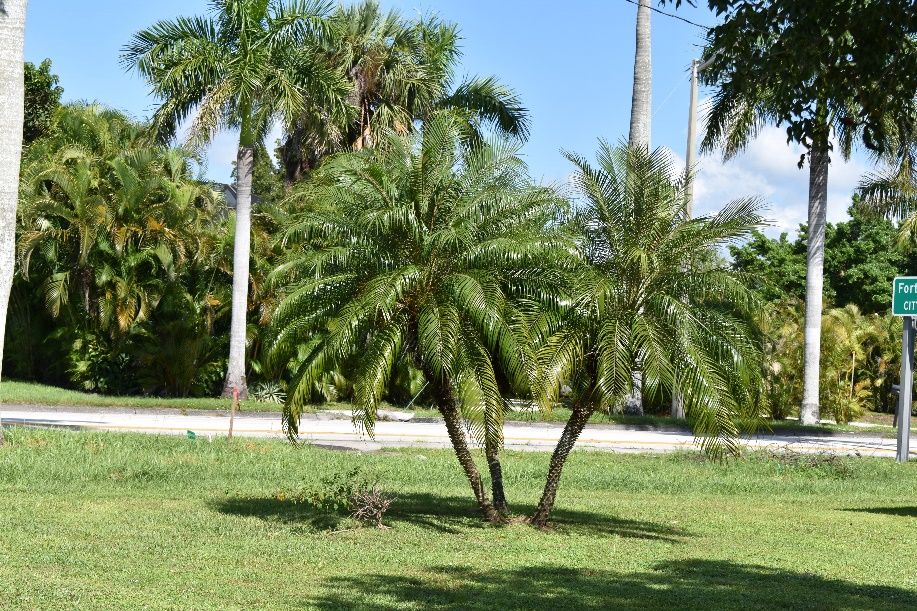
Credit: Stephen Brown, UF/IFAS
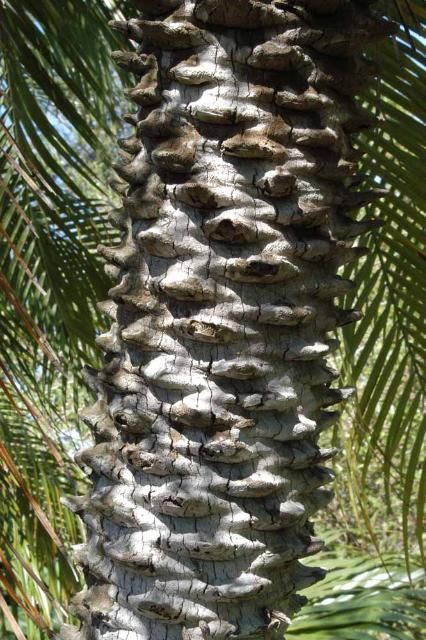
Credit: T. Broschat, UF/IFAS
Pygmy date palms are adaptable to a wide range of soil types. They are considered to be cold hardy to USDA zone 10A (30°F), but are widely grown in zone 9B (25°F). They are not tolerant of salt spray or saline soils. Most pygmy date palms in Florida exhibit potassium (K) deficiency symptoms on their oldest leaves. Symptoms are most severe towards the tips of affected leaves and appear as a yellow-orange discoloration of the leaflets and necrosis of the leaflet tips (Figure 3). Potassium deficiency also causes premature leaf death, so K-deficient palms retain fewer leaves than healthy ones. Potassium-deficient leaves, though unsightly, should not be removed until they are completely dead, as they serve as a supplementary source of K in the absence of sufficient K in the soil. Proper fertilization will gradually increase the number of leaves in the crown. Once a fully round crown has been achieved, visible symptoms of K deficiency will also begin to disappear. Landscape palm fertilizers should have an analysis of 8-2-12 (or 8-0-12) with 100% of the nitrogen (N), K, and magnesium (Mg) in controlled release form, and micronutrients such as manganese (Mn) and iron (Fe) in water soluble (sulfate or chelate) form in order to be effective. For more information about K deficiency and fertilization of landscape palms in Florida, see EDIS publications EP269 and EP261.

Credit: T. Broschat, UF/IFAS
Another nutrient deficiency occasionally encountered on pygmy date palms is Mg deficiency. Symptoms of Mg deficiency is similar to those of K deficiency but differ in that Mg-deficient leaves have a broad yellow band along the outer margin of each leaf, with the center of the leaf sharply transitioning to dark green (Figure 4). Unlike potassium deficiency, magnesium deficiency does not cause leaflet tip necrosis. While K deficiency is nearly ubiquitous on pygmy date palms in Florida, Mg deficiency is usually the result of improper fertilization. Fertilizers with high N or K, but little or no Mg, applied to the palm or nearby turfgrass can result in imbalances between N and Mg or K and Mg that can result in Mg deficiency. Routine application of the fertilizer mentioned above will prevent Mg deficiencies and can be used to correct mild to moderate Mg deficiencies. For more information about Mg deficiency see EDIS publication EP266.
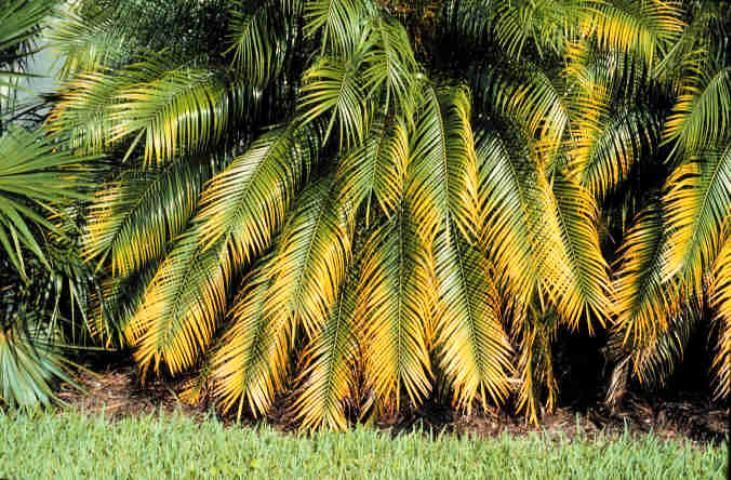
Credit: T. Broschat, UF/IFAS
Iron (Fe) deficiency is uncommon in pygmy date palms but can occur on palms planted too deep or in poorly drained soils. Symptoms appear on the new leaves as a uniform chlorosis (yellowing of the leaflets). In severe chronic situations, the entire palm may be yellow-green in color. Iron deficiency is best prevented by planting at the correct depth and avoiding planting into sites with poor drainage or high-water tables. Since Fe deficiency is not actually caused by a lack of Fe in the soil, Fe fertilizers may not always be effective in treating the problem. See Iron Deficiency in Palms (EP265).
Manganese (Mn) deficiency is a common problem in pygmy date palms growing in alkaline soils. Symptoms begin as longitudinal necrotic streaks on slightly chlorotic leaflets (Figure 5). As the deficiency progresses, leaflet tips become withered and curled, giving the leaves a frizzled appearance (Figure 6). Symptoms of Mn deficiency develop on newly emerging leaves and are most severe towards the base of those leaves. Routine fertilization with the 8-2-12 fertilizer mentioned above should prevent most Mn deficiencies, but severe cases may require supplemental applications of manganese sulfate. For more information about Mn deficiency in palms see EDIS publication EP267.
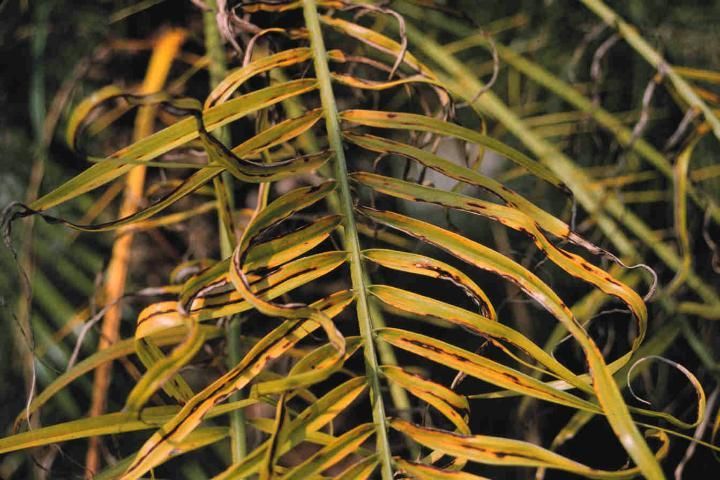
Credit: T. Broschat, UF/IFAS
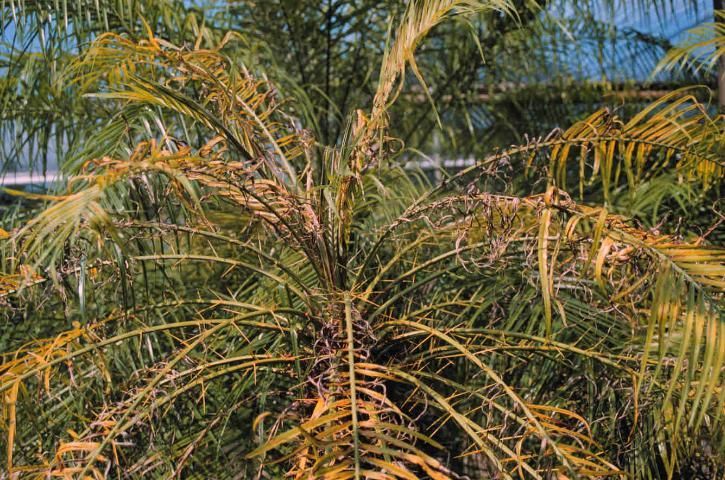
Credit: T. Broschat, UF/IFAS
Boron (B) deficiency is fairly common on pygmy date palms. Although a wide range of symptoms are possible, the most common is the production of several spear leaves that do not open normally, if at all (Figure 7). Crumpled dark green new leaves are also occasionally produced as a result of this disorder. See EP264 for more information about B deficiency in palms.
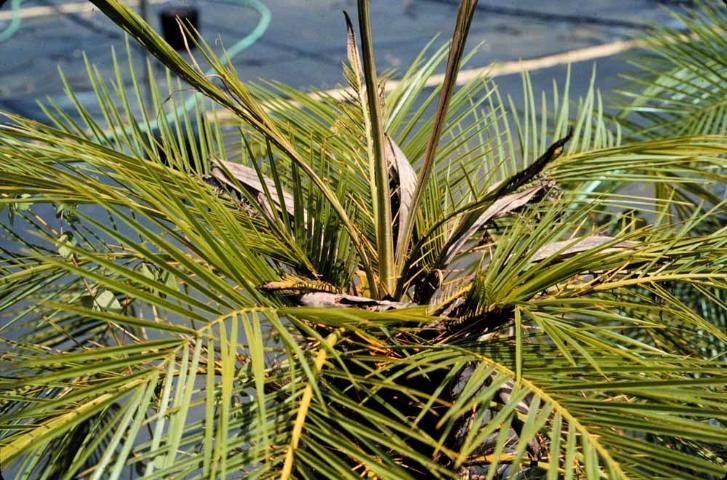
Credit: T. Broschat, UF/IFAS
Pygmy date palms are relatively resistant to diseases, but two diseases are fairly common in this species. Ganoderma butt rot, a soil-borne fungal disease caused by Ganoderma zonatum, causes decay in the bottom couple of feet of the trunk (Figure 8). There is no control for this disease. Another common disease, particularly during cooler months, is Pestalotiopsis leaf spot, which causes necrotic lesions on the leaflets, rachis, and petioles (Figure 9). In severe cases, this disease can kill the palm.
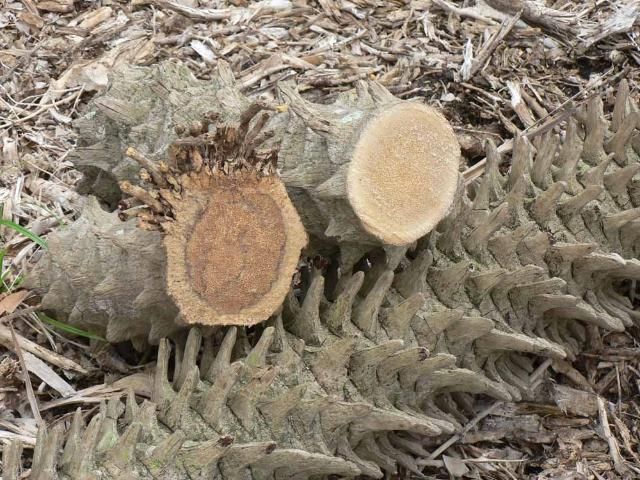
Credit: T. Broschat, UF/IFAS
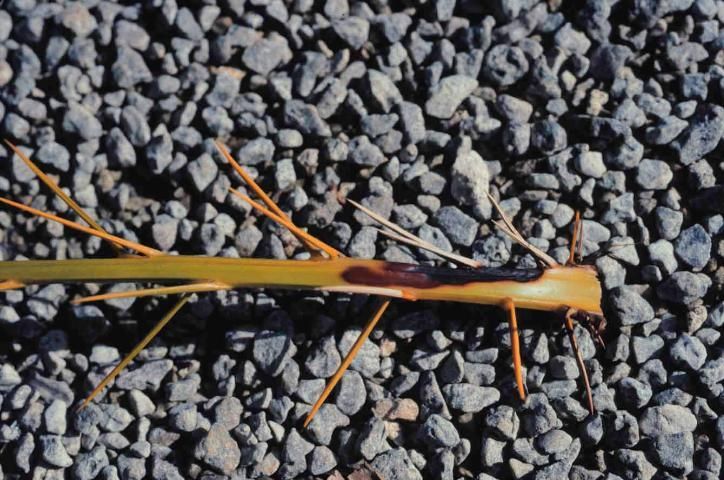
Credit: T. Broschat, UF/IFAS
Pygmy date palms are occasionally damaged by mites and insects such as mealybugs, scales, weevils, and caterpillars. Young leaves of pygmy date palms are normally covered with a whitish material (Figure 10) that is often mistaken for a whitefly, mealybug, or scale infestation. This material drops off naturally as the leaves age.
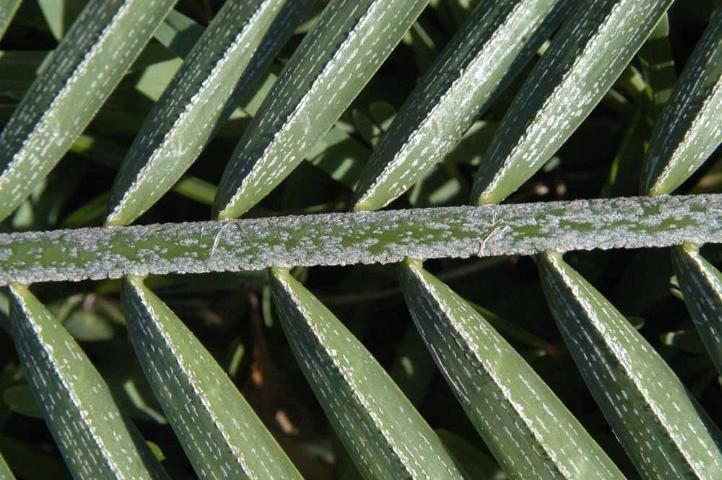
Credit: T. Broschat, UF/IFAS
References
Broschat, T. K. 1994. "Removing potassium-deficient leaves accelerates rate of decline in Phoenix roebelenii O'Brien." HortScience 29:823.
Elliott, M. L., T. K. Broschat, J. Y. Uchida, and G. W. Simone. 2004. Compendium of diseases and disorders of ornamental palms. St. Paul, MN: Amer. Phytophathological Soc. Press.
Meerow, A. W. 2006. Betrock's landscape palms. Hollywood, FL: Betrock Information Systems.